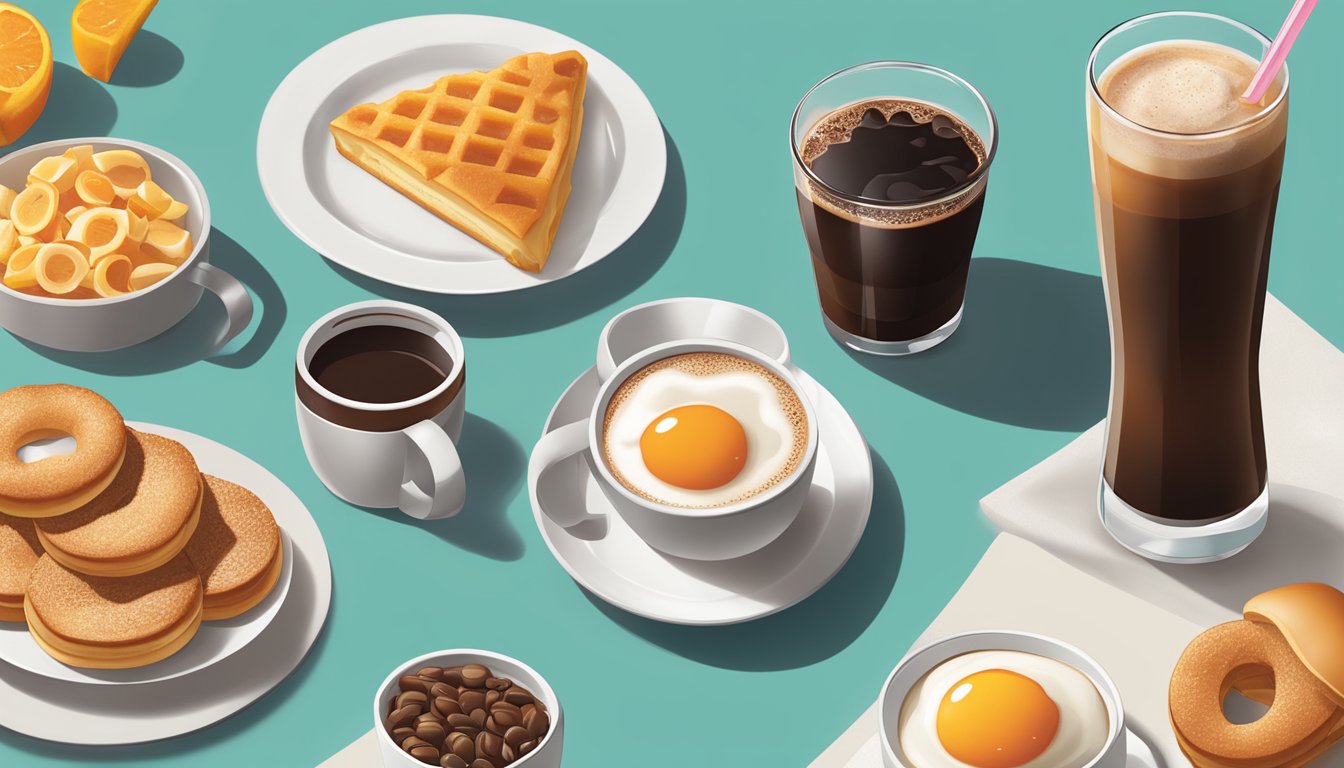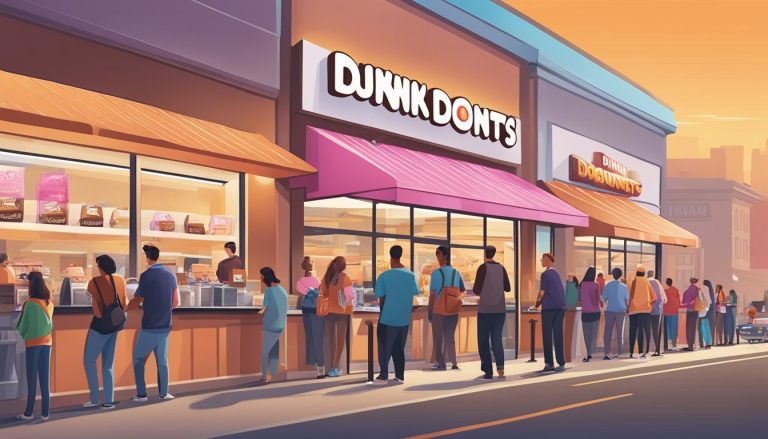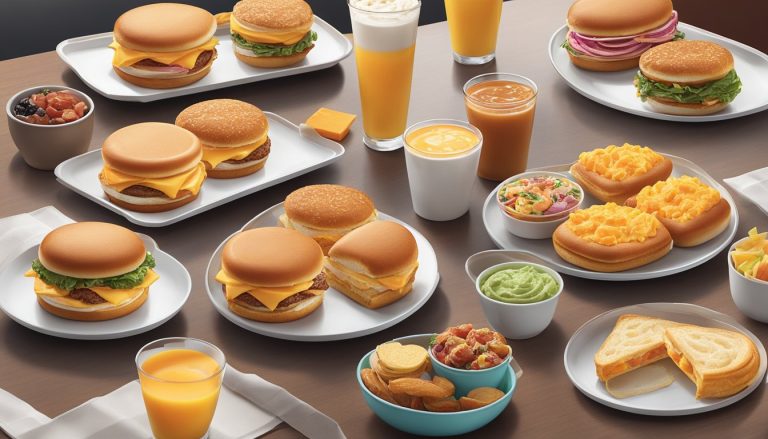Dunkin’ has been a beloved staple in the breakfast scene for decades, but in recent years, one menu item has taken center stage – Cold Brew coffee. This smooth, rich beverage has captivated coffee lovers and transformed morning routines across the nation. Dunkin’s Cold Brew, introduced in 2016, has become a game-changer in the competitive breakfast market, offering a refreshing alternative to traditional hot coffee.
The rise of Cold Brew at Dunkin’ reflects a broader shift in consumer preferences towards cooler, more indulgent coffee options. As temperatures rise and tastes evolve, Cold Brew has emerged as a popular choice for those seeking a bold, less acidic coffee experience. Dunkin’ has capitalized on this trend, positioning its Cold Brew as an affordable luxury for everyday consumers.
Dunkin’s success with Cold Brew has not only boosted its coffee credentials but also reinforced its position as a convenient breakfast destination. By offering a high-quality Cold Brew alongside its classic menu items, Dunkin’ has attracted a new generation of customers while retaining its loyal base. This strategic move has helped the brand stay competitive in a rapidly changing breakfast landscape.
Dunkin’s Journey and Brand Evolution
Dunkin’ has transformed from a local donut shop to a global coffee and breakfast powerhouse. Its journey reflects changing consumer tastes and strategic brand positioning over decades.
From Open Kettle to Espresso Bars
In 1948, William Rosenberg opened Open Kettle in Quincy, Massachusetts. Two years later, he renamed it Dunkin’ Donuts. The shop quickly gained popularity for its fresh donuts and coffee.
By the 1960s, Dunkin’ Donuts embraced franchising, fueling rapid expansion. This model allowed the brand to grow while maintaining quality and consistency across locations.
In the 1980s and 1990s, Dunkin’ diversified its menu. It added muffins, bagels, and breakfast sandwiches to cater to changing consumer preferences and on-the-go lifestyles.
Expansion of Dunkin’s Market Share
Dunkin’s growth strategy focused on saturating markets and building customer loyalty. By 2000, it had over 5,000 locations worldwide.
The brand continued to innovate, introducing espresso-based drinks in 2003 to compete with Starbucks. This move marked Dunkin’s shift towards becoming a beverage-led company.
In 2018, Dunkin’ Donuts rebranded to simply “Dunkin’.” This change reflected its expanded offerings beyond donuts and positioned it as a modern beverage company.
Comparison with Competitors
Dunkin’ faces stiff competition from Starbucks and McDonald’s in the coffee and breakfast market. Each brand has distinct strengths:
| Brand | Strengths |
|---|---|
| Dunkin’ | Affordable prices, quick service, strong regional loyalty |
| Starbucks | Premium image, extensive drink customization, café atmosphere |
| McDonald’s | Widespread locations, value menu, drive-thru efficiency |
Dunkin’ differentiates itself through its emphasis on “America runs on Dunkin’” branding and focus on efficient service for busy customers.
The brand continues to adapt to market trends, introducing cold brew coffee and plant-based options to appeal to younger consumers and health-conscious individuals.
Cold Brew Coffee Craze
Cold brew coffee took the coffee market by storm, appealing to health-conscious consumers and coffee lovers alike. This innovative brewing method sparked a revolution in customer preferences, reshaping the coffee industry landscape.
Development of Dunkin’s Cold Brew Coffee
Dunkin’ introduced cold brew coffee to its menu in 2016, following Starbucks’ lead from the previous year. The company’s cold brew is steeped in cold water for 12 hours, creating a smooth, flavorful beverage. This method differs from traditional iced coffee, which is brewed hot and then cooled.
Dunkin’s cold brew quickly gained popularity among customers seeking a refreshing, less acidic coffee option. The company expanded its cold brew offerings to include flavored variants and even a nitro version, priced competitively at $3.99 for a single size.
Cold Brew Coffee and Consumer Trends
Cold brew coffee’s rise reflects shifting consumer preferences towards smoother, less bitter coffee options. Its sweet and smooth taste appeals to a wide range of coffee drinkers, from young adults to seasoned coffee enthusiasts.
The trend aligns with growing health consciousness, as cold brew is often perceived as a healthier alternative to traditional coffee drinks. Its lower acidity makes it easier on the stomach for some consumers.
Cold brew’s popularity has led to increased innovation in the coffee market. Coffee shops and brands continue to experiment with new flavors, brewing techniques, and serving methods to meet evolving customer demands.
Menu Innovation and Diversification
Dunkin’ has continually expanded its menu offerings to cater to evolving consumer tastes. The chain now provides a diverse range of food and beverage options beyond its traditional donuts and coffee.
Introduction to Dunkin’s Diverse Menu
Dunkin’ has transformed from a simple donut shop to a comprehensive breakfast and beverage destination. The menu now includes a wide array of hot and cold drinks, savory breakfast items, and sweet treats.
Coffee remains a cornerstone, with options ranging from classic drip to espresso-based beverages and iced coffees. The introduction of Cold Brew in 2016 marked a significant shift, appealing to younger consumers and driving sales growth.
Dunkin’ also offers tea, frozen drinks, and energy drinks to cater to various preferences.
Breakfast Sandwiches and Baked Goods
Dunkin’ has significantly expanded its breakfast sandwich lineup. Options include:
- Egg and cheese on bagels, croissants, or English muffins
- Bacon, ham, or sausage variations
- Veggie egg white flatbreads
The chain has also diversified its baked goods selection:
- Bagels in various flavors
- Muffins and croissants
- Specialty donuts and donut holes
These additions have helped Dunkin’ compete more effectively in the breakfast market.
Seasonal Offerings and Limited-Time Promotions
Dunkin’ regularly introduces seasonal items and limited-time promotions to keep its menu fresh and exciting. These offerings often align with holidays or changing seasons.
Examples include:
- Pumpkin-flavored drinks and baked goods in fall
- Peppermint mocha during winter holidays
- Fruity iced tea flavors in summer
These promotions generate buzz and encourage repeat visits from customers eager to try new items before they disappear.
Ethical Sourcing and Sustainability Initiatives
Dunkin’ has implemented several initiatives to address consumer concerns about sustainability and ethical sourcing:
- Sourcing 100% Rainforest Alliance Certified™ coffee beans
- Transitioning to cage-free eggs
- Removing artificial dyes from products
The company has also focused on reducing its environmental impact:
- Phasing out foam cups in favor of double-walled paper cups
- Offering reusable cup programs in some locations
- Exploring more sustainable packaging options
These efforts aim to appeal to environmentally conscious consumers while improving the company’s sustainability profile.
Dunkin’s Coffee Mastery
Dunkin’ has evolved from a donut shop to a coffee powerhouse, offering a diverse range of high-quality beverages. The company’s commitment to coffee excellence is evident in its specialty drinks, premium offerings, and innovative cold brew.
Specialty Coffee Drinks
Dunkin’ boasts an impressive array of specialty coffee drinks. Their menu features classic espresso-based beverages like lattes, cappuccinos, and macchiatos. Each drink is crafted with precision, using freshly ground espresso beans and steamed milk.
Seasonal flavors and limited-time offerings keep the menu exciting. Dunkin’ regularly introduces new flavor combinations to cater to changing customer preferences.
The company also provides customization options. Customers can choose their preferred milk type, sweeteners, and flavor shots to create personalized drinks.
Premium Coffee Offerings
Dunkin’ has elevated its coffee game with premium offerings. Their Original Blend remains a staple, but they’ve expanded to include dark roast and decaf options.
The company sources high-quality Arabica beans from around the world. These beans are carefully roasted to bring out their unique flavors and aromas.
Dunkin’ also offers whole bean and ground coffee for at-home brewing. This allows customers to enjoy their favorite Dunkin’ coffee anytime.
Cold Brew as a Beacon for Quality Coffee
Cold brew has become a standout product in Dunkin’s coffee lineup. Introduced in 2016, it quickly gained popularity among coffee enthusiasts.
Dunkin’s cold brew is made by steeping a special blend of coffee in cold water for 12 hours. This process results in a smooth, rich flavor with low acidity.
The company has expanded its cold brew offerings to include flavored options and nitro cold brew. Nitro cold brew, infused with nitrogen gas, provides a creamy texture and cascading effect when poured.
Cold brew’s success has solidified Dunkin’s reputation as a serious coffee destination. It demonstrates the company’s ability to adapt to trends while maintaining quality.
Operational Efficiency and Convenience

Dunkin’ has streamlined its operations to maximize efficiency and convenience for customers. The brand’s focus on quick service and technological integration has significantly enhanced its competitive edge in the breakfast market.
Drive-Thru and Quick Service Model
Dunkin’ prioritizes speed and accessibility through its drive-thru model. Many locations feature minimal in-store seating, allowing for faster service and reduced overhead costs. This strategy aligns with the brand’s target demographic of on-the-go consumers seeking quick breakfast and coffee options.
Drive-thru lanes are optimized for efficiency, with menu boards designed for easy ordering and rapid service. Staff are trained to handle high-volume periods, ensuring consistent speed even during peak hours.
Mobile Ordering and Speed of Service
Dunkin’ has embraced mobile technology to further enhance convenience and service speed. The Dunkin’ mobile app allows customers to place orders in advance, reducing wait times and streamlining the in-store experience.
Mobile ordering integrates seamlessly with Dunkin’s operational model. Dedicated pickup areas for mobile orders help manage store traffic and maintain efficiency. The app also offers personalized promotions and loyalty rewards, encouraging repeat visits and increasing customer engagement.
This digital approach has proven particularly valuable during busy morning rushes, enabling Dunkin’ to serve more customers without compromising on speed or quality.
Deepening Customer Engagement
Dunkin’ has implemented strategic initiatives to foster stronger connections with its customers. These efforts focus on rewarding loyalty and building community ties.
Dunkin’s Loyalty Programs and Rewards
Dunkin’ offers the DD Perks Rewards program to incentivize repeat purchases. Members earn points for every dollar spent, which can be redeemed for free beverages. The program provides personalized offers based on customer preferences and purchase history.
Mobile ordering through the Dunkin’ app enhances convenience for loyalty members. It allows for quick, customized orders and contactless payment options.
Seasonal promotions and limited-time offers keep the rewards program exciting. These may include bonus point events, discounted menu items, or exclusive access to new products.
Community Engagement and Brand Loyalty
Dunkin’ actively participates in local community events and initiatives. The brand sponsors youth sports teams, charity runs, and educational programs in many areas.
The company’s “Dunkin’ Joy in Childhood Foundation” supports children’s health and hunger relief organizations. This philanthropic effort strengthens Dunkin’s image as a socially responsible brand.
Dunkin’ leverages social media to connect with customers on a personal level. They share user-generated content, respond to feedback, and create engaging campaigns that resonate with their audience.
Local franchisees often tailor their involvement to community needs, further embedding Dunkin’ into the fabric of neighborhoods across the country.
Marketing Strategies and Retail Growth
Dunkin’ has employed targeted marketing strategies and retail expansion to solidify its position in the competitive breakfast market. The company’s focus on cold brew offerings has played a key role in attracting new customers and increasing market share.
Adapting to Coffee Giants and Market Dynamics
Dunkin’ has strategically positioned itself against coffee giants like Starbucks by emphasizing affordability and convenience. The company has expanded its retail presence, opening new locations in high-traffic areas and non-traditional venues such as airports and universities.
To boost market share, Dunkin’ has invested in drive-thru capabilities and mobile ordering technology. These initiatives have improved customer experience and increased operational efficiency.
Dunkin’ has also adapted its menu to cater to changing consumer preferences, introducing healthier options and plant-based alternatives. This flexibility has helped the brand maintain relevance in a dynamic market.
Innovative Marketing Campaigns and Promotions
Dunkin’ has launched creative marketing campaigns to promote its cold brew offerings. The company has leveraged social media platforms, particularly TikTok, to reach younger audiences.
Notable promotions include:
- Collaborations with influencers and celebrities
- Limited-time flavor releases
- “Free Cold Brew Mondays” promotions
These campaigns have successfully increased brand awareness and driven sales growth. Dunkin’ has also utilized data-driven marketing strategies to personalize promotions and target specific customer segments.
The brand’s merchandise marketing strategy has further bolstered its popularity. Dunkin’-branded apparel and accessories have created additional revenue streams and enhanced brand loyalty among customers.
The Role of Coffee in Breakfast Consumption

Coffee plays a central role in many people’s breakfast routines, often pairing with various morning foods. Its popularity stems from both its energizing effects and diverse flavor offerings.
Consumer Habits and the Importance of Coffee
Coffee consumption is a daily ritual for over 60% of Americans. This beverage has become an integral part of breakfast culture, with many viewing it as essential to start their day. Fast food chains like Dunkin’ have capitalized on this trend, expanding their coffee offerings beyond traditional hot brews.
Cold brew and espresso-based drinks have gained significant traction, especially among younger consumers. The rise of smartphone ordering at chains like Dunkin’ has made grabbing a morning coffee even more convenient.
Single-serve coffee machines have also seen a 50% growth in sales between 2015 and 2020, indicating a shift in at-home coffee consumption habits.
Breakfast Items and Coffee Pairings
Coffee and breakfast foods often go hand-in-hand, with many consumers seeking complementary flavor profiles. Dunkin’ has strategically positioned itself in this market by offering a range of breakfast items alongside its coffee menu.
Classic pairings include:
- Donuts and hot coffee
- Bagels with iced coffee
- Breakfast sandwiches and espresso drinks
Dunkin’ has introduced healthier options like the Power Breakfast Sandwich to cater to health-conscious consumers. This protein-packed item pairs well with their Energy Cold Brew, which contains espresso for an extra morning boost.
The company’s shift towards a coffee-focused identity reflects changing consumer preferences. By offering a variety of coffee options and breakfast foods, Dunkin’ aims to meet diverse customer needs throughout the morning rush.
Environmental Responsibility and Certifications

Dunkin’ has taken significant steps to enhance its environmental responsibility and obtain important certifications for its coffee sourcing practices. The company is working to improve sustainability and ethical standards across its supply chain.
Rainforest Alliance Certification and Impact
Dunkin’ has partnered with the Rainforest Alliance to certify its coffee sourcing. This certification ensures that coffee is grown using methods that protect forests, soil, and waterways. It also promotes better working conditions for farmers.
Rainforest Alliance certification has led to improved biodiversity on coffee farms supplying Dunkin’. The program encourages shade-grown coffee, which preserves habitats for native plants and animals.
Farmers in the certification program receive training on sustainable agriculture techniques. This has resulted in increased crop yields and quality for many participants.
Commitment to Ethical Practices and Global Standards
Dunkin’ has launched the Drive-To Sustainability Program, pledging 100% responsibly sourced coffee by 2025. This initiative focuses on verification, partnerships, and continuous improvement.
The company is collaborating with Enveritas, a non-profit organization, to address poverty among smallholder coffee growers. This partnership aims to overcome systemic barriers in coffee-growing communities.
Dunkin’ is working with the Farmworker Training Project to enhance supply-side sustainability. The program will train 350 coffee farming families in best practices.
By participating in The Sustainable Coffee Challenge, Dunkin’ is contributing to industry-wide efforts to make coffee the world’s first fully sustainable agricultural product.




